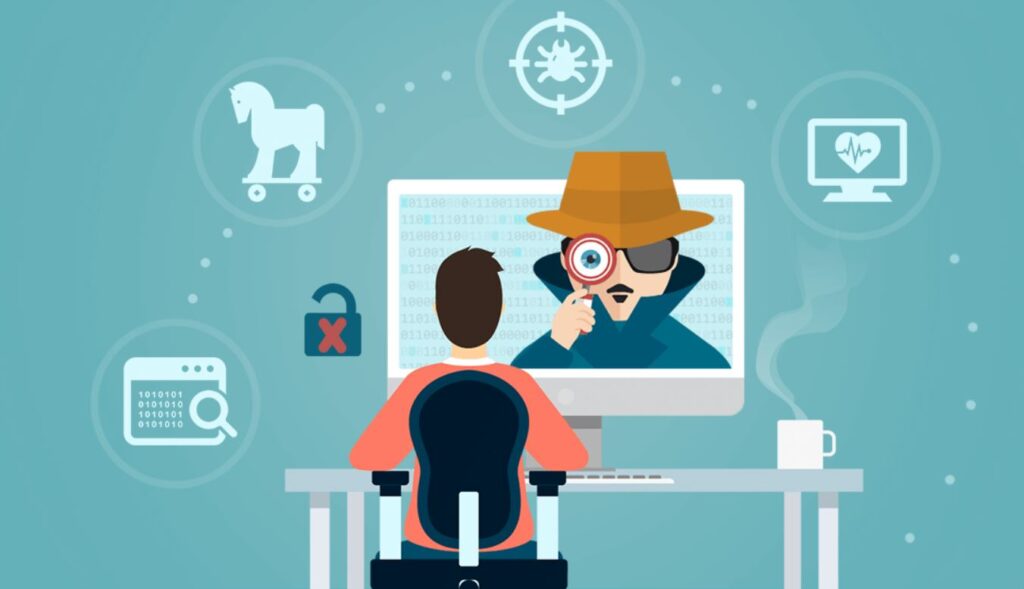iPhone and Android users are both facing more sophisticated spying risks than ever before. Do you believe you are being tracked? Here’s what you should do right now.
There are numerous techniques to prevent a government agency, country, or cybercriminal from intruding on our digital life, such as employing virtual private networks (VPNs), end-to-end encryption, and browsers that do not track user activity.
Cybersecurity Best Practices to Protect Your Digital Assets
Accept it: Your personal and company data is constantly under attack, and securing your digital assets while you shop, bank, and play online is still the top priority. Here’s some good news: There are more security-focused products and tactics accessible today than ever. Appsrs most recent cybersecurity recommendations provide practical advice on how to be secure and productive today while dealing with an ever-changing threat landscape tomorrow.
However, once spyware has been installed on a system, it can be extremely hard to detect and remove.
This article will go over the various types of malicious software that could come up on your iOS or Android handset, the warning signals of infection, and how to get rid of such pestilence from your mobile devices — whenever possible.
We will also discuss stalkerware and other ways that risks closer to home may spy on you, as well as what you can do to prevent it.
What Is Spyware?

Spyware comes in numerous forms, and before you can address the issue, it’s helpful to understand the fundamental differences.
Nuisanceware is frequently packaged with legitimate applications. It interrupts your web browsing with pop-ups, alters your homepage or search engine settings, and may collect your browser history to sell to advertising firms and networks.
Although classified as fraudulent advertising, nuisance-ware is often neither unsafe or a threat to your basic security. Instead, these malware packages are designed to generate unlawful cash by infecting machines and forcing users to watch or click ads.
There is also basic spyware. These generic types of malware take operating system and clipboard data, as well as any potentially valuable information, such as bitcoin wallet data or account passwords. Spyware is not always targeted, and it might be used in common scams.
Phishing, malicious email attachments, social media links, or fake SMS messages can all lead to the installation of spyware.
Advance Spyware
Advanced spyware, often known as stalkerware, is a step above simple malware. This unethical and sometimes hazardous virus can be found on desktop computers, but it is now most typically implanted on smartphones. Spyware and stalkerware can be used to monitor emails, SMS, and MMS messages sent and received; to intercept live calls for surveillance across standard telephone lines or Sound over IP (VoIP) applications; to secretly capture environmental noise or take photos; to track victims using GPS; or to hijack social media apps like Facebook and WhatsApp. Stalkerware may also have keylogging functionality.
Harmful Stalkerware is often used to monitor an individual’s actions, words, and movements. Stalkerware is frequently associated to instances of domestic abuse.
Finally, there is government-grade commercial spyware. Pegasus is the most well-known recent case, which was presented to governments as a weapon for counter-terrorism and law enforcement. Pegasus was ultimately discovered on devices belonging to journalists, activists, political dissidents, and lawyers.
Signs Of Spyware Attempts Into Your Device

There are various symptoms to look for that could indicate you are being targeted by a spyware or stalkerware provider.
Receiving strange or unexpected social media messages or emails may indicate a spyware infection attempt. You should remove these without clicking any links or downloading any files.
The same is true for SMS messages, which may contain links that lead you to unintentionally download malware.
Also, this legendary ransomware has discovered a new target.
To catch the target off guard, these phishing communications will trick you into opening a link or running software that contains spyware or stalkerware payload. If the malware is being loaded remotely, user participation is required, thus these messages may attempt to alarm you, such as demanding payment to a tax agency or bank or appearing as a failed delivery notice. Messages could also contain faked addresses from a source you trust.
When it comes to stalkerware, the initial infection messages may be more personal and specific to the victim.
Physical access is required, or the victim may install malware by accident. Some spyware and stalkerware can be installed in less than a minute.
If your phone goes stolen or has been out of your control for a while and reappears with new settings or alterations that you do not recognize, this could be an indication of tampering.
Signs That Spyware Is On My Phone?
You may notice sudden phone battery loss, overheating, and unusual behavior from the device’s operating system or apps. Settings like as GPS and location services may activate unexpectedly, or you may experience random reboots. If you suddenly use a lot more data than usual, it could mean that information is being sent from your smartphone or that remote connections are active. You may also have difficulty turning off your smartphone entirely.
Certain types of malware designed to generate false money may be able to gain enough access to affect your bank balance. If you have signed up for services or premium SMS plans and you are aware that you did not consent to them, this could indicate that spyware is installed on your device. Keep a check on your credit cards for any indications of strange activity.
It is crucial to note that spyware or other forms of harmful software can sometimes come up on your device through an otherwise benign app. There have been instances where developers release a legitimate, helpful program in official repositories, such as a currency converter or weather app, and then, after a substantial user base has been gathered, the developers change the app’s functionality.
Also read about: Trojan Virus – Your Complete Guide to Identifying and Eliminating Trojan Malware
Last year, Google banned fraudulent apps from the Google Play Store that were masquerading as Bluetooth utilities and had been downloaded by more than a million people. While the apps did not appear dangerous at first, users were soon struck with advertisements and pop-ups.
Spy software is becoming complex and difficult to detect. However, not all types of spyware and stalkerware are invisible, and it is easy to determine whether you are being monitored.
Android devices can be identified by a setting that allows downloading and installing apps from sources other than the Google Play Store.
If this setting is enabled, it could suggest tampering and jailbreaking without your permission. However, not all forms of spyware and stalkerware require a jailbroken device.
This option is available in most contemporary Android releases under Settings > Security > Allow unknown sources. (This varies by device and seller.) You can also check programs > Menu > Special Access > Install unknown programs to see if anything unfamiliar appears, but spyware is not certain to be on the list.
Spyware Signs Might You See On Android And iOS Devices?
Some spyware uses generic names and icons to prevent detection. For example, they could look to be a useful utility software like a calendar, calculator, or currency converter. If a process or program appears on the app list that you are unfamiliar with, a short online search might help you determine whether it is real.
Non-jailbroken iOS devices are less susceptible to malware installation compared to Android handsets unless a zero-day or unpatched vulnerability is exploited. However, the following malware principles apply: With the correct tool, exploit, or software, your device can be compromised either physically or remotely. You may be more at risk for an attack if you have not upgraded your iPhone’s firmware to the most recent version and do not conduct frequent antivirus scans.
However, both iOS and Android phones will often indicates signs of malware infection.
Steps to Remove Spyware
Once you’ve identified potential signs of spyware, it’s crucial to take swift and effective action to remove it from your mobile device. Follow these comprehensive steps to ensure a thorough and successful spyware removal process:
Update Your Software
Begin by ensuring that your device’s operating system, apps, and security software are up-to-date. Updates often include patches for known vulnerabilities, strengthening your device’s defenses against spyware.
Install a Reputable Antivirus App
Choose a trustworthy antivirus or anti-malware app from a reputable developer. Conduct a full system scan to detect and remove any potential threats lurking on your device.
Review App Permissions
Regularly review and manage the permissions granted to each app on your device. Disable unnecessary permissions that seem invasive or unrelated to the app’s core functionality.
Uninstall Suspicious Apps
Identify and uninstall any suspicious apps immediately. Pay attention to apps you don’t remember installing or those with poor reviews, as they may harbor spyware.
Clear Browser Data
Spyware often exploits vulnerabilities in your device’s browser. Regularly clear your browser’s cache, cookies, and history to minimize the risk of infection.
Factory Reset
If all else fails, consider performing a factory reset on your device. This drastic measure will erase all data, including spyware. However, ensure you back up essential information before proceeding with a reset.
Steps To Avoid Advanced Spyware Like Pegasus

Government-grade spyware can be harder to detect. There are several activities you can take to reduce the danger of being subjected to such surveillance, based on current research and findings:
Reboots: To prevent persistence, reboot your device on a daily basis. The majority of infections appear to be based on zero-day exploits with low persistence; thus, rebooting can impede attackers.
Disable iMessage and FaceTime (for iOS): iMessage and FaceTime, which are enabled by default, are ideal targets for exploitation. A number of new Safari and iMessage exploits have emerged in recent years.
Use an alternative browser than Safari or the default Chrome: Some hacks do not work as well with alternatives like Firefox Focus.
Use a reliable, paid VPN provider, and install an app that alerts you when your device has been jailbroken. Some antivirus applications will also run this check.
Individuals who fear they have a Pegasus infection should also utilize a secondary device, preferably one running GrapheneOS, to communicate securely.
How To Protect Device From Spyware
Google and Apple are generally quick to tackle malicious apps that manage to avoid the privacy and security protections imposed in their respective official app stores.
Protect Your Device Physically
The first line of defense is to maintain proper physical controls. Modern smartphones allow you to set PIN numbers and patterns, as well as use biometrics such as fingerprints or retina scans, to prevent physical tampering with your cellphone.
Update your Operating System
When system updates become available, ensure that they are installed in a timely manner. One of the most essential defenses against malware is the inclusion of security fixes and patches.
Use antivirus software
Mobile antivirus solutions exist that can identify and eradicate spyware. Running periodic scans will assist to secure your handset.
Download Programs From Official Sources
The majority of spyware and viruses are discovered outside of Google Play and Apple’s App Store, so be wary about downloading programs from third-party websites.
Look Out For Fraudulent Links
Phishing and malicious links, which are distributed via platforms such as social media services, are common methods of spreading mobile malware. These URLs may prompt you to download apps from sources other than Google Play or the App Store, and they may be disguised as anything from antivirus software to streaming services.
Don’t Jailbreak Of Your Device
Jailbreaking not only voids your warranty, but it also allows harmful apps and software to gain a strong footing in your operating system, making uninstallation exceedingly difficult, if not impossible.
Enable Two-Factor Authentication
When account activities and logins demand additional permission from a mobile device, this can help protect individual accounts. (However, spyware can intercept codes sent during 2FA protocols.)
Conclusion
safeguarding your mobile device from spyware requires a proactive and comprehensive approach. By staying vigilant, regularly updating your software, and following the recommended steps for spyware removal and prevention, you can significantly reduce the risk of compromising your privacy and security. Remember, an informed and proactive user is the first line of defense against the stealthy threat of spyware in the digital age.
Many people search for ways to enhance wifi speed. As you and I know, dead zones are one of the reasons, but there are other variables that slow down your wifi signal. I have prepared a blog on it to get you out of this frustrating position, and I have included a blood link right below.


